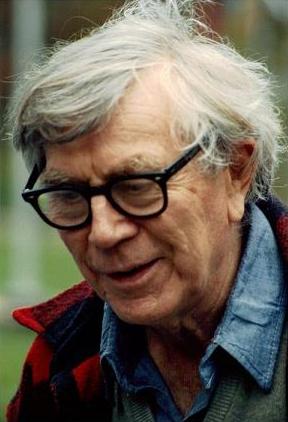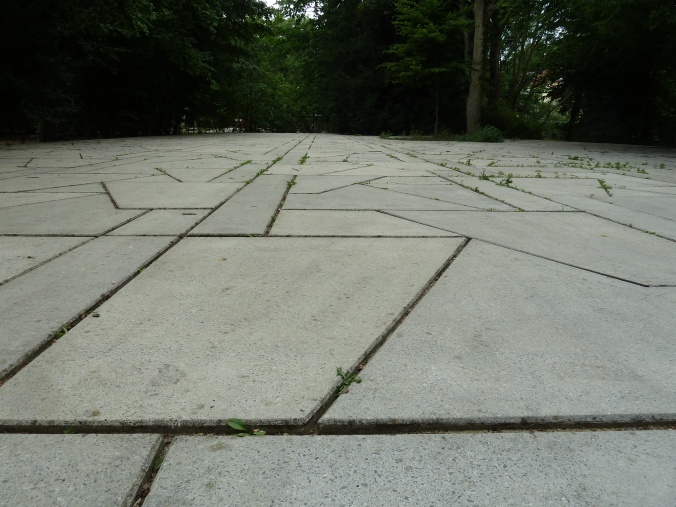Since this article is about an artist from the United States of America, I would like to try and write in English. This is dedicated to all my English speaking and writing friends and followers and especially to my dear aunt Pat in British Columbia, Canada.
I think it’s very important to make art that you have to wait for. … you have to wait and you have to wonder what happens next.
-George Rickey, in his studio at East Chatham, New York (from: The George Rickey Foundation, georgerickey.org)
In the beginning there were just three rotary squares (Drei rotierende Quadrate in German) … and nowadays, Münster loves not just the Rickey sculpture at Engelenschanze but all of the works that stayed there from the once-in-a-decade-exhibition since 1977. But …
… let’s start with an explanation:
The modern art event Sculpture Projects (Skulptur Projekte) is now just as famous as the documenta in Kassel. But back in 1974, even before it was invented, the residents of Münster were not that open minded for this kind of art – being exposed in outdoor public spaces, not traditionally behind the doors of a museum…
Three Rotary Squares
The first sculpture ever to stand at a public green space alongside a road called Engelenschanze in Münster was Three Rotary Squares, which George Rickey build at the age of 66 in 1973. At first, an official municipal art committee chose this kinetic sculpture of the already renowned artist for Münster – but the purchase failed due to scepticism and the tendency of many residents to consider it an eyesore, even though the artist himself was content to give a discount… we’ll pick up on that later…
And who was George Rickey?
George Warren Rickey was born on the 6th of June in 1907 in South Bend, Indiana. He died at the age of 95 on the 17th of July 2002 in Saint Paul, Minnesota.
Rickey grew up in Scotland, because his father had worked for the famous Singer Sewing Machine Company and moved the family to Glasgow when George was about 6 years old.
He later studied history in Oxford and art in Paris and returned to the USA as a teacher, his focus primarily on painting and portraits. But when he was 35, he left and joined the army for a wartime work in aircraft and gunnery systems research and maintenance – that was in 1942, in World War II, and presumably, his interest in all things mechanical re-awakened by then.
Eventually, he was discharged and returned home again, finishing his art studies in New York at the Institute of Fine Arts and at the Chicago Institute of Design, to resume teaching afterwards.
After World War II, in 1945, his first „Mobiles“ made of stainless steel and glass were born. In the 1950, Rickey was a really passionate sculptor: His first kinetic sculpture was exhibited in New York at the Metropolitan Museum of Art in a group show.
New York – Berlin
Most of his work he created in his studio at East Chatham, New York, but he also was creative and productive in Berlin, Germany, where he lived as scholarship holder (German Academic Exchange Service, DAAD) and build his sculptures for exhibitions like the documenta in Kassel and others.
The source of his kinetic work flow
In a retrospective at the Snite Museum of Art (South Bend, Indiana) in 1985, he explained about the source of his moving objects and kinetic sculptures:
In World War II, Rickey was assigned to design machine gun turrets for bombers. Doing this, he became familiar with balancing weights, riveted sheet metal, lightweight aircraft construction techniques, and modern hardware. These were to become the mechanical foundation for his later forays into lightweight, delicately balanced, wind-activated kinetic sculpture he is still famous for.
So the war and its challenges got Rickey to develop his kinetic art? I call on you:
Make Art Not War!
George Rickey’s remains were buried on the wooded hillside behind his home and studio in East Chatham, New York.
The George Rickey Foundation still runs exhibitions and preserves his memory.
But what happened when Münster rejected his
Three Rotary Squares?
On the 22nd of January in 1975, Ludwig Poullain (†2015, back then chairman of the former Westdeutsche Landesbank) decided to donate the Rickey-sculpture to the city of Münster!
Inspiration…
The extra long and unnerving public dialogue about contemporary art inspired Dr. Klaus Bußmann (the subsequent curator of the Landesmuseum, today called LWL-Museum für Kunst und Kultur) to initiate a forum how to face the presumptive paucity of information on contemporary art… and together with the still active Kasper König gave birth to the first Sculpture Projects in 1977!
Today…
Today, in 2017, Rickey’s Three Rotary Squares are incorporated within the public image of the the city of Münster. They are occasionally joined by some beer-drinking punks in the sunshine.
Many marvellous works from the preceding Sculpture Projects (1977, 1987, 1997, 2007) remained in Münster, some very famous and beloved (like the „landmark“ Giant Pool Balls by Claes Oldenburg at Lake Aa), and some little-known (like We Are Still And Reflective by Martin Boyce, at the former site of the zoo).
All Münsteran residents and colleagues I talked to are happy to have this international exhibition in our little big city. I take pride in the words: Ich bin eine Münsteranerin! 😉
Even though curator Kasper König is not that amused about the „misplaced enthusiasm“ – he thinks, art should be controversial and provocative. In 2007, he said in an interview:
„At the end of the day, people here are more excited by pumpernickel than by art.“
from: Sculpture Invasion in Münster. The Art World Goes Provincial. By Cameron Abadi, SPIEGEL Online 22nd of June, 2007 (click!)
As the current Sculpture Projects are running until the 1st of October 2017, you should come and visit Münster NOW – there are many things to discover, and not all of the works are sculptures: performances and installations and many more are waiting to be enjoyed!
If you want to discover the older or the latest sculptures in Münster but don’t know how or where to start, contact or visit the LWL-Museum für Kunst und Kultur at Domplatz in the middle of Münster, or the Tourist Information – or drop me a line (mail to tuermerin[at]muenster[dot]de).
And if you would like to read more things on Münster and about the things Münster bloggers like and share, please click HERE (münsterBLOGs).

